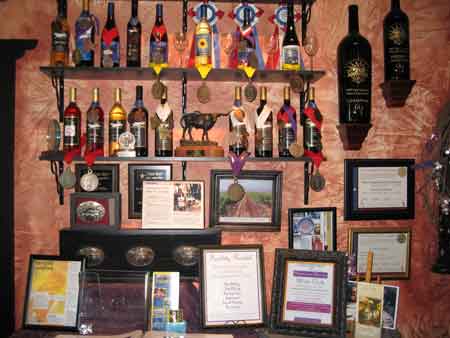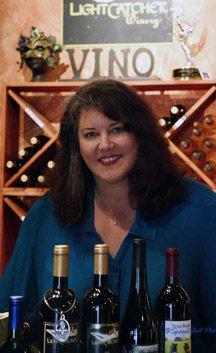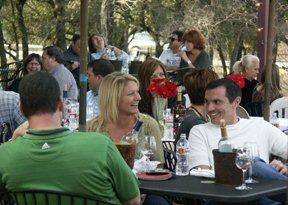
LightCatcher Winery: A Touch a Wine Magic
From the awards LightCatcher’s co-owner and winemaker, Caris Turpen, has garnered in her short winemaking career, one has to say that she is doing something right. Is it magic?
Caris has gone from a successful career in film photography to a position of notoriety in Texas winemaking with near seamless perfection. It is like her Hollywood experience actually ‘set the stage’ for her current Texas oenological performance.
When asked, Caris makes a very direct link between her two careers. On a recent visit, she confided to me, “I was once asked about my connection between film and wine and I said that making a film was ‘art and science stirred by ego’, while winemaking was ‘art and science stirred by mystery’. While these words came out quickly and easily, I really did not understand the actual connection until I thought about it more thoroughly.”
 “In winemaking,” she said, “you are given a source of nature (the grapes) that gives what it can and you cannot totally predict the outcome in advance. Photography is also driven by nature in occurrences and surroundings that often happen spontaneously. I always thought that I had the ability of foresight and a sense of purpose that allowed me to anticipate things. I was always looking forward.”
“In winemaking,” she said, “you are given a source of nature (the grapes) that gives what it can and you cannot totally predict the outcome in advance. Photography is also driven by nature in occurrences and surroundings that often happen spontaneously. I always thought that I had the ability of foresight and a sense of purpose that allowed me to anticipate things. I was always looking forward.”
Highly honored cinematographer, Haskell Wexler, gave Caris what she described as her best professional compliment. As she related, “He said that I had ‘the ability to see beyond the needs of the camera’. I think that this is the same skill that I bring to winemaking. I feel that I have the ability to anticipate what I need to do in the cellar to produce a wine that is the best possible expression of the grapes.”
I first tasted wines from LightCatcher Winery during the 2004 Texas’ Best Wine Competition. Caris submitted her LightCatcher 2002 Merlot made from grower Neil Newsom’s high plains Texas fruit. Like Barking Rocks Winery mentioned in my previous article, LightCatcher was also one of the new up-and-coming Texas wineries that were real “eye-openers” for the judges that year. They commented on Caris’ Merlot in terms of a well integrated expression of big fruit and oak with a deep purple color, well structured tannins and a mature character. These are comments that you do not always expect to hear about a young winemaker’s wines, except if she has a good grasp on the ‘mysteries’ of her craft.
Her exploits in winemaking, have not come without trials. Caris started as an amateur winemaker and indicated that her initial effort was far from memorable. She commented, “I started with a book (From Vines to Wines), some grape concentrate and a home wine maker’s kit. Unfortunately, I was mortified with the outcome. But, you know, this actually made me even more determined to make good wine.”
From there, Caris found a grape supplier that shipped her quality grapes and she gave it a second try. After a few more attempts, she came away with a Silver Medal in the Lone Star Wine Competition’s non-commercial division. As she admits, her determined goal was to master winemaking to the point where she could actually make a wine of similar quality to the $20 to 30 bottles that she was used to drinking. It was through this goal, hard work and determination that eventually resulted in her the ability to work with grapes and make them yield, as she describes, as “their best expression”.
However, after the success in the non-commercial wine competition Caris realized that she had “hit the wall” as a hobbyist and she still wanted to learn more. This pushed her to work all the angles to raise her game to a higher level. Caris went to TWGGA Grape Camp and Texas High Plains Grower Neil Newsom’s Field Day near Lubbock to learn more. She also pursued a formal education to support her winemaking adventure by doing most of the two year degree program at Grayson College under the tutelage of professors George Ray and Roy Mitchell. During this learning process she was recommended for a job in the cellar with Dr. Bobby Smith at La Buena Vida Winery. This opportunity put her in the cellar three days a week for nine months.
According to Caris, “All of the testing, lab work, dosing, racking and retesting at LBV winery was the best experience that I could have asked for. Then, the light bulb came on in my head….I could indeed make high quality wine and we could actually have a small winery. I realized that the only real difference between my hobby and a big winery operation was the factor of scale. My husband Terry and I visited wineries in California with the intent to ask questions and learn more about the business side of a winery operation. Our goal was to be a 2000 case micro-winery.”
In less than five years from start-up of LightCatcher, they surpassed their initial goal and are trying to settle in at around 3500 cases annually. Caris is now working on making their winery a destination combining their tasting room, Sunday jazz and wine events, and their restaurant – Bistro LightCatcher. LightCatcher is also hosting a number of weddings and private parties.

I asked Caris about the changes she has experienced in the Texas wine scene since she started. She first mentioned how Texas grape growers are shifting their strategy and are now trying to plant warm weather grape varieties more suited for the Texas climate. She feels that grape growers have done their homework by planting many test rows to narrow down the candidates that can grow here and the acceptance with consumers of new varietals with names like Syrah, Grenache, Tempranillo, Sangiovese and Viognier has been positive based on her experience.
Additionally, the big changes that she feels have stimulated the Texas wine industry have been changes in Texas laws that now permit wineries in dry areas around the state and the sales from winery tasting rooms in these locales. These changes have grown the number of wineries in Texas from 60 only a few years ago to over 160 today. From this, Caris indicated she has seen a growing consumer interest and knowledge that some Texas wines are actually of similar quality to the wines that they buy from other, more established, wine producing regions.
Caris is particularly thankful to the pioneers of Texas wines that, as she says, “got consumers to put down a longneck and pick up a wine glass.” These people were the visionaries that helped to build consumer awareness and confidence. She particularly noted the contributions of Pat Brennan at Brennan Vineyard for his work with warm weather varietals like his Viognier, which Caris admits has a “big Ju-Ju going on there”. Other acknowledgements go to her good friend and grower, Neil Newsom who has led the movement from cotton to Cabernet on the high plains, and Ed Auler for tailoring wines for the mass demand in Texas.
Caris is particularly high on Texas wines that work with the culture of Texas and that integrate with its hot weather and spicy foods. To punctuate this, she says that Syrah-blends and Viognier are examples of new Texas-style wines that are on the top of her list. She particularly notes the efforts at McPherson Cellars and La Diosa in Lubbock that make well-crafted wines and presents them with wonderful tapas-style foods. She also gives credit to Paul Bonarrigo at Messina Hof who works tirelessly on building market recognition for Texas wines and to getting his wines on restaurant wine lists throughout the state. She feels that this is an important step in building visibility and credibility with Texas consumers.
In closing, Caris emphasized to me that there is a magic in good winemaking that is just hard to explain. She says, “Each wine is different and that her approach is on awareness to these differences and to anticipate what she needs to do as a winemaker.” In her mind, winemaking is almost something metaphysical that involves a connection with her surroundings directed by her sense of purpose, fueled by a dose of magic.
LightCatcher Winery
6925 Confederate Park Road/FM1886, Fort Worth, TX 76108
Phone: (817) 237-2626
Fax: (817) 237-1629
Web site: www.lightcatcher.com
Caris and Terry Turpen, Owners
Tours, Tastings, Sales, Music Events, Facility Rental, Catering, Bistro
Situated 15 miles northwest of downtown Fort Worth, the winery and tasting room are located on treed acreage that provides a serene escape. Caris specializes in “big reds” as well as whites that offer, as she says, “as much entertainment value as a red.” The winery features wine tastings, an eclectic gift shop, and relaxed dining with indoor and outdoor seating. Bistro LightCatcher offers upscale “new American” foods to pair with their wines. Lunch and dinner service is available three days a week. Live jazz twice a month draws big crowds year-round.Visit and enjoy all LightCatcher has to offer – fine food, music, art and the finest Texas wines.
Visitors Welcome:
Wed-Thu-Sun noon-6pm;
Fri-Sat noon-9pm;
Bistro Service
Fri-Sat noon-8pm;
Sun noon-5pm

Thank you for an article that shows the depth of your listening, and that expresses a wider view of the industry, in your choices of what to ask and what to highlight. This is most unusual. I am quite used to reading about what a winemaker tried to do with a particular wine, but not about the underlying philosophy, if you will, about their profession.
You are making a case for the definition of ‘Texas terrior’, as is your stated goal. That can be a frustrating task, since Texas terrior comes not just in the soil or climate of any given vineyard, and wineries and vineyards are so often separated by physical as well as cultural differences; you are making headway on an evolving definition.
My hat’s off to you!